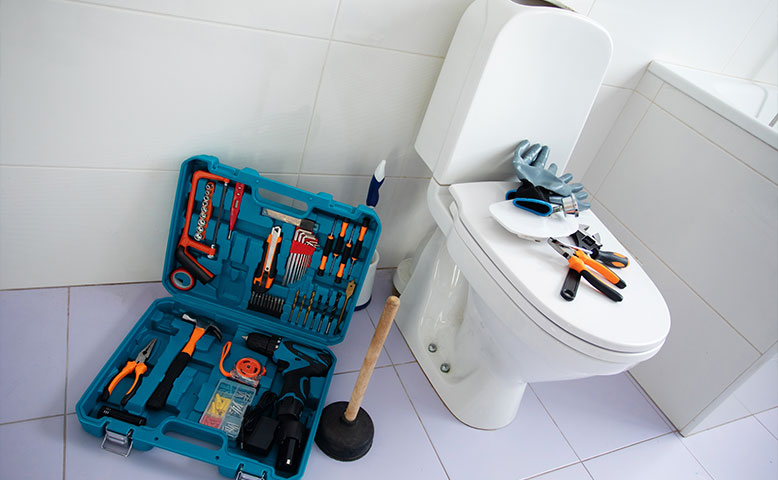A kitchen can look fine on paper—enough square feet, a decent row of cabinets—yet still feel as tight as a studio pantry. The trouble starts when work zones overlap, bulky doors swing into traffic lanes, and daylight never reaches the prep board. Soon, you bump elbows while chopping, shuffle pans like chess pieces, and push chairs aside just to pour coffee. Noise echoes off hard corners, steam hangs in the air, and every task takes one step more than it should. That fatigue pushes families to order take-out instead of gathering to cook. The good news: the same footprint can perform far better. A thoughtful remodel removes barriers, redirects traffic, and lets storage work double duty. Here’s how specific design moves solve the squeeze.
Cabinet Crowding Shrinks Walking and Working Space
Standard base cabinets measure 24 inches deep. Line them on parallel walls only 36 inches apart, and you create a pinch point narrower than most airline aisles. Throw in doors that open outward, and two cooks become one frustrated tourist.
A remodel starts by mapping clearances:
48-inch aisle width keeps a fridge door from clipping knees.
270-degree hinges let doors fold flat instead of jutting out.
Full-extension drawers slide contents forward so nobody leans over open doors.
Replacing bulky framed boxes with frameless versions gains roughly 2 inches inside every drawer without moving a wall. Shallow pantry pull-outs hold dry goods vertically—a cereal box viewed spine-out needs just 8 inches. When cabinets suit what they store, you stop stacking skillets in the oven, and the walkway grows wider overnight.
Poor Lighting Hides Surface Area You Could Use
Under-cabinet shadows steal usable counter real estate. Knife skills feel risky when you can’t see julienne lines, so you spread cutting boards toward the sink, clogging space meant for dishes.
Enter a layered light plan:
Ambient: Recessed LED cans supplying 30–40 lumens per square foot.
Task: 1-inch LED tape under uppers, 3000 K temperature for true food colors.
Accent: Thin puck fixtures inside glass fronts that draw eyes upward, adding the illusion of height.
LED strips are just 3/8-inch thick and tuck behind a simple light rail, drawing 4 watts per foot yet outshining yesterday’s fluorescent tubes. With counters fully lit corner to corner, you reclaim twelve to eighteen inches of prep zone once lost in gloom—and the room suddenly feels broader.
Outdated Layout Blocks the Natural Cooking Flow
Architects once favored the “triangle” rule: sink, stove, fridge at the three points. Families now need coffee bars, instant-pot stations, and recycling zones, so the path zigzags. Every extra pivot makes the kitchen feel tighter than the tape says.
Designers now talk about task clusters:
A water station combines a sink, dishwasher, disposal, and pull-out trash.
A heat station groups a cooktop, a wall oven, a spice drawer, and a utensil pegboard.
A cold station pairs a fridge, snack pantry, and a microwave.
Moving the fridge four feet can trim daily steps by half a mile over a year. Swap a fixed island for one with a 12-inch overhang on two sides, and stools slide underneath instead of blocking traffic. The square footage stays, yet the route clears like morning roads after school break.
Aged Utilities Claim Drawers and Countertop Corners
Old houses hide bulky cast-iron vents, copper lines, and tangle-loop wiring behind sheetrock. They carve notch after notch into cabinet backs, eating storage volume.
A remodel reroutes services with modern materials:
PEX tubing bends on a 3-inch radius, gliding inside walls without elbows.
Low-profile range hoods vent through 4-inch ducts instead of 7-inch cans.
Shallow receptacle boxes free an extra inch behind drawer kits.
Free of awkward soffits, uppers rise to the ceiling, adding a shelf row equal to two full cabinets over the span. Hidden utilities also boost safety—separate 20-amp appliance circuits, curb breaker trips when the air fryer and toaster run together. The by-product is pure bonus space: no more lost corner where the old vent once lurked.
Smart Storage Solutions Open Every Hidden Nook
A well-planned drawer glider costs less than replacing square feet of floor. Think vertical, pivoting, and pocket hardware:
Diagonal dividers slot frying pans on edges, saving stacking time.
Swing-out blind-corner trays pull a full 15-inch rack into the light.
Toe-kick drawers hide baking sheets where ankles used to bump.
Technical note: soft-close slides rated at 100 lb use full-extension ball bearings, lasting 75,000 open-close cycles—nearly 20 years of daily dinners. By lifting dry goods to eye level and pushing seldom-used roasters to toe-kick bins, you keep work tools within a single arm’s sweep. Less bending means fewer accidents, and an orderly cabinet makes the room look larger even before paint hits the walls.
Light Plans and Colors Stretch Visual Boundaries
Physics proves light bounces: matte paint scatters rays while glossy paint reflects them. Choose a satin finish at 65-GU (gloss units) for uppers, and it returns up to 50 percent more light than eggshell. Pair that with quartz counters carrying a faint speckle: no busy grain to confuse the eye, yet enough texture to mask crumbs. Good color theory uses LRV (Light Reflectance Value).
Aim for:
Uppers: 75 LRV—soft white or pale gray.
Bases: 45 LRV—mid-tone for grounding.
Floor: 30 LRV—warm wood tone that hides scuffs.
This deliberate contrast keeps foot traffic centered while sightlines sail across shiny doors to the backsplash, tricking the brain into reading extra depth. Even eight-foot ceilings seem taller when crown molding matches door faces and draws the gaze upward.
Energy-Efficient Fixtures Slash Heat And Kitchen Traffic
Old incandescent bulbs throw 90 percent of their energy as heat. That warmth gathers near the cooktop, pushing helpers toward cooler hallways. Swap to ENERGY STAR-rated LEDs and you lower heat output by two-thirds. Couple that with an induction cooktop drawing 7,200 watts but sending 85 percent of the power into the pan, not the room.
The ripple effects:
Shorter cook times—water boils in 90 seconds, cutting idle minutes.
Quieter ventilation—smaller hoods handle lower ambient heat.
Lower bills—families save about 200 kWh yearly on lighting alone.
Technical spec: modern induction units need a 40-amp breaker and 8-gauge wire; most dated ranges run on 50-amp 6-gauge, so the upgrade fits existing panels. Cooler air and quicker meals invite more people back into the workspace instead of fleeing to the living room, making the area feel open by mood as well as measure.
Conclusion – Room to Cook, Room to Live
Cramped kitchens aren’t doomed by walls; they’re pinched by cluttered storage, dim corners, and outdated gear. Smart cabinet swaps, layered lighting, efficient layouts, and cooler appliances free the same square footage to serve like rooms twice the size. When every utensil has a home and every step feels easy, cooking stops being a chore and becomes family time once more. If you’re ready for that change, Royal Design Remodel Repair Inc translates these proven fixes into plans, permits, and polished results—so tomorrow’s dinner starts in a kitchen that finally fits.

